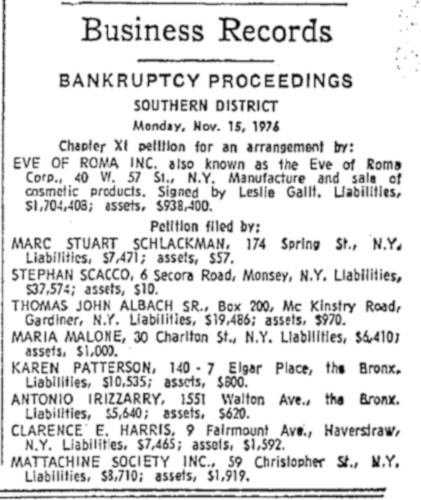
Mattachine Society Office
overview
In July 1972, the Mattachine Society Inc. of New York, one of the city’s most influential early gay rights groups, mostly for men, moved its office downtown to Christopher Street, which had become increasingly popular after the Stonewall uprising of 1969.
The influence of the organization was already being superseded by the younger and more radical activist LGBT groups formed after Stonewall. It filed for bankruptcy in 1976.
History
Founded in Los Angeles in 1951, with a New York Area Council in 1955, the Mattachine Society Inc. of New York was one of the city’s early and most influential “homophile” (gay and lesbian) rights groups. At the time, it was considered radical for campaigning for the rights of gay men and lesbians to simply exist openly in society without fear of arrest or persecution. Under the innovative leadership of president Dick Leitsch (who was in that role from 1965 to 1970), Mattachine challenged the State Liquor Authority’s discriminatory ban on serving gay people at the famous “Sip-In” at Julius’ in 1966. It also worked to stop police entrapment of gay men, and provided legal advice and counsel to arrested men.
The second floor of this building was Mattachine’s last office, from July 1972 until the chapter was dissolved in 1976. The location is particularly poignant, as it is just three buildings away from the Stonewall Inn. The slightly older leaders and members of Mattachine were replaced in influence by the younger and more radical activist LGBT groups formed after the Stonewall uprising in 1969.
When the organization moved here, however, there was a spirit of optimism from a change in leadership and its relocation downtown to increasingly popular Christopher Street. Mattachine’s previous offices were at 1133 Broadway near Madison Square Park (1958-68) and 243 West End Avenue on the Upper West Side (1968-72). The move was enabled by the bequest of $10,500 in the will of merchant seaman Albert Fahner. One member in 1972 remarked:
The new place needs lots of work, but it’s going to be nice, particularly with the now-necessary air conditioning, and we’re hoping for lots of off-the-street socializing, many committee uses of the library and meeting rooms, much individual counseling, and lots of printing material going out: I hope they’re right, and this will be the turning point for the organization…
A number of other groups met here as well: The Eulenspiegel Society; Gay Youth, after the arson fire at the Gay Activists Alliance Firehouse in October 1974; Gay Legal Caucus; New York State Coalition of Gay Organizations; Gay Arbitration Panel; Gay Democratic Club of Manhattan; Gay Medics; and Gay People at the New School. Mattachine New York filed for bankruptcy in November 1976.
Entry by Jay Shockley, project director (May 2019; last revised January 2023).
NOTE: Names above in bold indicate LGBT people.
Building Information
- Architect or Builder: attributed to Peter R. Christie and Gilbert J. Bogart
- Year Built: 1853
Sources
Bob Zolnerzak, Autobiography; Mattachine – Diary 3013. Mattachine Board at 59 Christopher, May 3, 1972, bit.ly/2DAwBHc. [source of pull quote]
“Business Records – Bankruptcy Proceedings,” The New York Times, November 16, 1976, 59.
Gay Activists Alliance, “New York State List of Gay Organizations,” c. 1973-74.
“Legal Clinic Established,” GAY, February 26, 1973.
“Mattachine is Moving,” Gay Scene, vol. 3, no. 2 (1972), 15.
“Mattachine is Moving…,” New York Mattachine Times, June 1972.
Mattachine Society Inc. of New York lease, April 26, 1972. Mattachine Society New York file, International Gay Information Center, Organizations, Manuscripts and Archives Division, The New York Public Library.
Rostom Mesli, In Defense of Identity Politics: A Queer Reclamation of a Radical Concept (University of Michigan dissertation, 2015), 181-182.
“Statewide Services Available to Gays,” in Gay Alliance of Genesee Valley, The Empty Closet, May 1974.
Stephan Cohen, The Gay Liberation Youth Movement in New York: “An Army of Lovers Cannot Fail” (New York: Routledge, 2008).
Do you have more information about this site?
This project is enriched by your participation! Do you have your own images of this site? Or a story to share? Would you like to suggest a different historic site?







